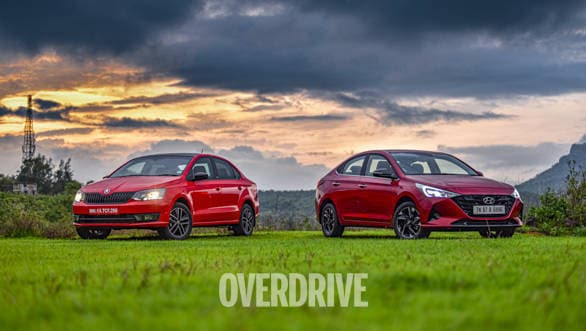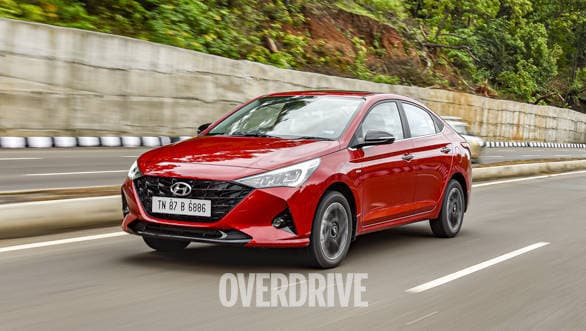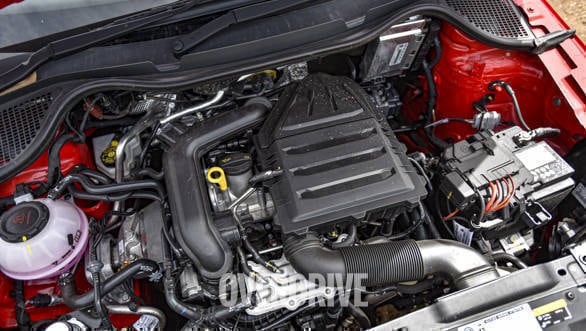Comparison test: Hyundai Verna vs Skoda Rapid 1-litre turbo petrol review
Long live the sedan! With the arrival of the all-new Honda City, the refreshed Hyundai Verna and Skoda Rapid, the mid-size sedan segment in India has some life breathed back into it. And in the case of the latter two, that life breath is squeezed, compressed and force fed! With the Verna and Rapid sporting exceedingly similar 1-litre turbocharged 3-cylinder engines, separated by the choice of transmissions available, both are set to entice the enthusiast with 110PS+ power figures and the promise of wads of torque. But which one is worth the money? Bravely venturing into the new world of Unlock 1.0 in Mumbai, here's the answer.

Styling
Sensuous sportiness. That's what Hyundai calls its Donckerwolke-led design language that's rolling out across its new cars. On the Verna, it might be the least polarising expression of it yet. What it brings is a larger grille, exclusively finished in gloss black for this Turbo variant, swept back headlights with a sharp LED DRL signature and sharper, simpler bumpers.


The result of the facelift, compared to the outgoing car, is stupendous. Seen from the front, the Verna looks expensive, modern and simply put, fast. In fact, you'd describe it the same way when viewed from the rear, with the detailed LED elements in the tail lights, a gloss black faux diffuser, the honey comb pattern across the trailing edge of the bumper and twin-tip exhausts the last touch quickly becoming the trademark of a Hyundai Turbo car. It all comes together to make the Turbo stand apart from even non-Turbo variants, which get a more elegant (if flashy) grille and bumpers.


Essentially, the Verna Turbo is very good news for an enthusiast, who wouldn't mind wearing his enthusiasm as a badge. On the other hand, we have the Rapid which looks exactly the same as it did when it was facelifted in 2017. The Monte Carlo edition does grab attention in its super bright shade of red but there's little else, gloss black trim and boot lip spoiler notwithstanding. That's not to say the Rapid isn't a handsome car, with its classic lines and proportions. Chances are you'll look back at either after you've parked it. The difference being, in the Verna, other people will too. Both cars ride on 16-inch wheels with machined faces, and wear 195/55 section rubber, though the Rapid's wheels do look like they fill out the arches better.
Cabin
The instant you open the door to the Verna, you realise just how far Hyundai's cabins have come, even considering the changes to the outgoing car are minor. The Turbo, again exclusively, has all-black interiors with red highlights in the AC vents and upholstery, with the central console ever so slightly canted towards the driver.


That extremely positive first impression is only taken further when you sink into the low-set driver's seat, and pull the chunky steering wheel out to you. Behind the wheel, the new all-digital display could show BMWs a thing or two about legibility while still looking sporty. Between the piano black trim and perforated leather upholstery, it's easy to overlook some of the hard plastics in the cabin. And that's before you start counting the features on the long list a powered driver's seat, ventilated seats up front, Apple/Android integration, connected tech, wireless charging and the all-important sun roof.


None of which is available on the Rapid, by the way. But it's a layout that works, with classic white on black dials, a superb flat-bottomed steering wheel and a seat that's set a little higher than the Verna. The Android tablet masquerading as infotainment is clunky, doesn't offer smartphone connection apart from Bluetooth, but surprisingly does a great job with audio quality from the Rapid's four speakers, compared to the Verna's six. The plastics in here feel equally hard and scratchy, and the Monte Carlo's leather upholstery doesn't feel as 'crafted' as the Verna's. Though, the solid, reassuring thunk when you close its doors is something the Verna can't quite match. Even with the lack of headline features, the Rapid still manages to score on usability with auto up/down for all four windows, and auto wipers, two features you don't get on the Verna.

However, when it comes to actually living with either, the Verna scores better with longer seat squabs front and rear, offering noticeably better under thigh support. Not to mention, there's a lot more space in the rear to stretch out. Sure, the Rapid gets window sun shades but they're more like accessories, while the Verna gets a retractable sun shade for the rear windscreen. There's not much between the two when it comes to boot space, with the Rapid's 460-litres comparing well to the Verna's 480-litres of cargo capacity.

While we don't usually address the feature spread across lower variants, it must be said the base Rapid Rider variant offers much of what makes the Rapid so usable, with the exception of driver's seat adjust, electrically folding mirrors and the touchscreen infotainment to name a few. You can't have the Verna Turbo in anything but fully-loaded for now, so there's no argument to be made there.
Safety features
Straight away, the Verna has a whole suite of electronic safety aids on its side, including traction and stability control, apart from disc brakes at all four corners. When you compare the six airbags on the Verna, the Rapid's two look inadequate, though the lower priced Style variant of the Rapid gets four. While we have a lot of faith in Skoda's build quality, as in Hyundai's, there is no replacement for a spread of airbags across the front and rear of the cabin. Both get rear parking cameras and sensors, while the Verna goes a step further in offering front parking sensors and a tyre pressure monitoring system as well.

Engine, performance and efficiency
For all the similarities in these two 1-litre 3-cylinder powertrains, the big difference on paper is that the Verna Turbo is only available as an automatic, while the Rapid is only available as a manual for now. While the Rapid TSI with a 6-speed torque convertor is expected in September, you'll have to row through the box yourself for now. Which is both, a good thing for the engagement the excellent gearbox offers, and a potential downside for someone looking for a car that'll primarily spend most of its life in city traffic. As a plus, the 7-speed dual clutch transmission on the Verna can also be controlled via nice and large paddleshifters behind the wheel.

From behind the wheel, the big difference in these two engines comes down to refinement and one wonders why the Verna didn't get the excellent 1.4-litre turbo that's in the Creta and Seltos. It's much harder to tell that the Rapid runs a three pot, with excellent sound deadening and NVH characteristics, a trait that even makes the Rapid a better choice than the Polo with the same engine. While you can hear a little bit of the characteristic three pot gruffness under 3,000rpm, it soon turns into a surprisingly full-bodied note as you make the supremely rewarding trip to its 6,600rpm redline. It can be quite an addictive trip too the Rapid had me wake early and venture out to my favourite road three days in a row!

In comparison, the Verna's motor sounds a little wheezy, and like it's running out of breath, even though it'll make the trip to redline with only a smidge less enthusiasm. Sure, the linear power delivery isn't as exciting as the Rapid's considerable and smile-inducing g forces under acceleration but with the wider spread of gear ratios, it ends up being more usable even if you were to drive around in manual all the time. The roll-on figures are quite telling here, with the Verna being between a 1.5-2s quicker throughout. Of course, if you let the DCT do its thing, that gap widens even further.

The flipside is that the Verna doesn't feel as quick off the line, with the DCT's penchance for self-preservation meaning full bore starts will only be in your imagination. It posted a strictly average 12.5s run to 100kmph from standstill, while the Rapid's 9.8s means it is several car lengths ahead by the tonne (and quicker than even the petrolhead's favourite, the Polo 1.2 DSG). Even with a rolling start, the Verna doesn't stand a chance, dropping out of the powerband with every gear shift, though the shifts themselves are fairly quick. It does tend towards more keeping the engine calm though, often refusing to downshift when approaching a corner, which means twisties are best tackled with use of the paddleshifters. For reference, the Verna 1.5 petrol manual manages the 0-100kmph dash in 11.5s but isn't as tractable, posting slower in-gear acceleration figures.

In normal everyday driving, you'd hardly notice any turbo lag from the Verna, but will have to pre-empt shifts to keep the Rapid above at least 1,500rpm if you don't want to deal with the frustration of a dead throttle pedal. In our comprehensive testing, the Verna comes out on top with considerably better fuel efficiency considering it's an automatic. But going by what we saw on the onboard computers, both will drop to the high single digits when pushed hard.
Ride and handling
These two litre-class sedans couldn't be any more different dynamically, despite running similar suspension components and rubber. The Verna is, expectedly, softer and more pliant (and a bit noisier) over bad roads but can actually suffer at speed because of it, running out of suspension travel over larger bumps or irregularities at speed, which also means that it's the only one that scraped its belly over monster speed breakers between the two. The Verna feels a lot tighter than it used to be but still not ideal. You can attack the same roads with great poise in the Rapid, and it'll even lift a wheel when encountered with mid-corner bumps but it still feels more predictable than the Verna.

The Rapid drives down the road with a reassuring heft from the steering, weighing up progressively with speed, and allowing you to get a sense from the loads on the front tyres in the corners, even if it's not bristling with feedback. That does mean it requires more effort when it comes to U-turns, an area where prospective Verna owners will likely appreciate the light action of the steering. Unfortunately, it feels too light and with too little feedback to gauge traction in fast corners accurately. Though turn in itself is quicker in the Verna, it tends to understeer at speed, while the Rapid settles on its suspension quickly and corners like it's on rails.

For most, and within limit, the Verna will prove to be an adequate handler. But if you really love driving, nothing comes close to the Rapid's impeccable body control. It's one of those cars that encourages you to turn off the music over a fast section of road, rather than turn the volume up. And surprisingly, despite all-around disc brakes on the Verna, the Rapid bests it in our braking tests, all the while providing great consistent bite right from the top of the pedal, while still allowing modulation.
Verdict
Just for the brilliance of the 1.0 TSI motor, the Skoda should win this. But ultimately this Monte Carlo variant at Rs 13.9 lakh (on-road, Mumbai) represents little value for money for what is an ageing package around a bomb of a drivetrain (though, the base variant is quite the opposite in value). The Verna, on the other hand, has made great strides all around and is quite desirable even at Rs 16.4 lakh, even if it only excels in certain areas the driving enthusiast may view as superficial. It's a more do-it-all, feel-good sort of car for the family that can also prove to be quick and fairly exciting. But if you're on a budget and want some pure fun, you should do yourself a favour and check out lower variants of the Rapid. I have, and I'm already rationalising the finance schemes to myself!

Starts Rs 9.31 Lakhs
1493cc
Automatic
115
250
-NA-
Starts Rs 7.49 Lakhs
999cc
Automatic
110
175
18.97 Kmpl
Starts Rs 10.9 Lakhs
1497cc
Manual
100
145
17.8 Kmpl














